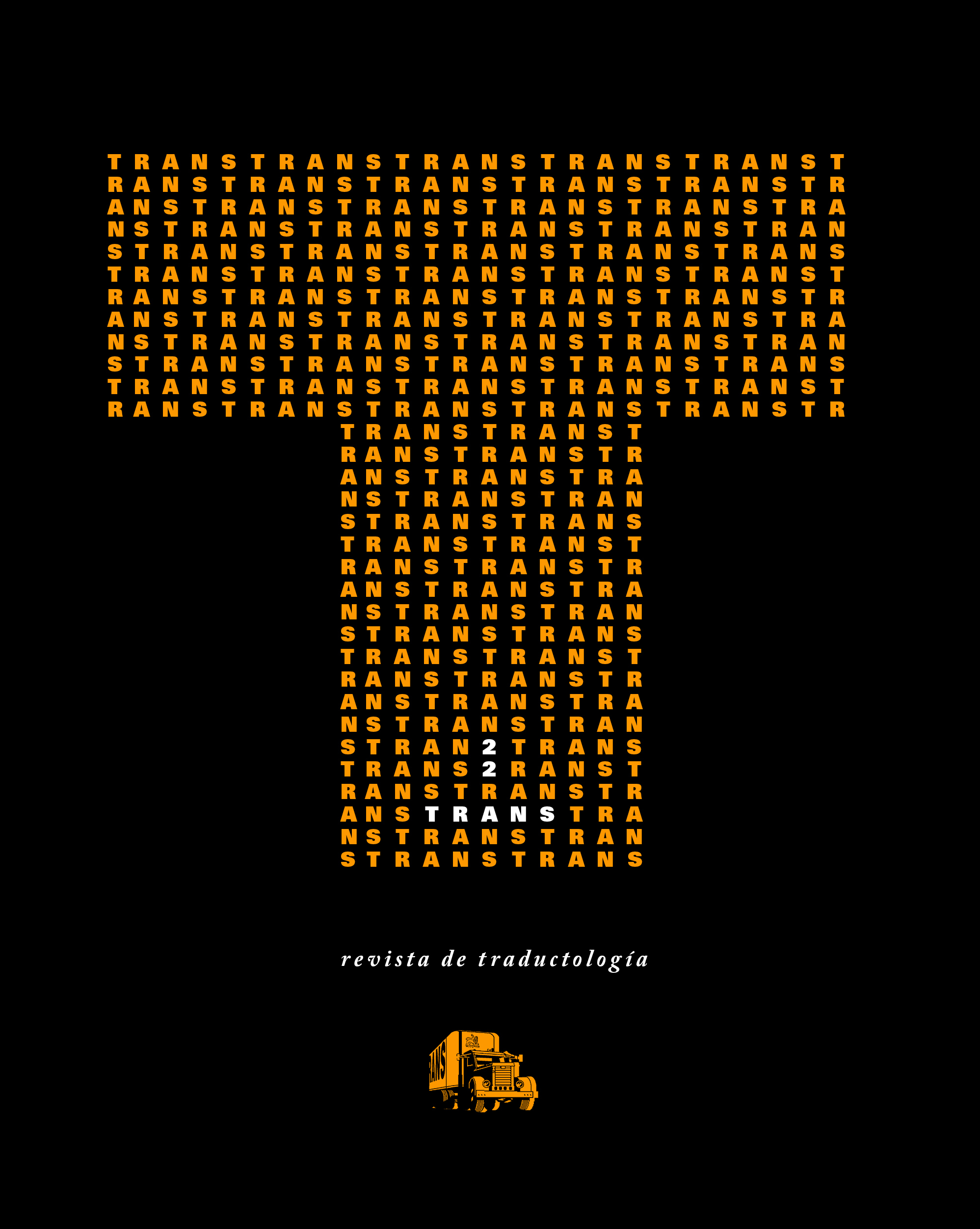Synchronization in Video Games: the Dubbing of Assassin’s Creed Syndicate
DOI:
https://doi.org/10.24310/TRANS.2018.v1i22.2966Keywords:
dubbing, audiovisual translation, localization, video games, synchronization, lip-syncAbstract
The aim of this article is to describe video game localization
from the new perspective of dubbing. More specifically, we
will focus on analyzing the types of synchronization in an
adventure video game localized from English into Spanish.
First, we will review the types of synchronization in cinema
and television described to date and proceed to use this dubbing
in movies and TV as the model to compare and analyze
the new interactive audiovisual product of video games.
Downloads
Metrics
Publication Facts
Reviewer profiles N/A
Author statements
Indexed in
-
—
- Academic society
- N/A
- Publisher
- Universidad de Málaga
References
APPERLEY, Thomas H. (2006): «Genre and game studies: Toward a critical approach to video game genres», Simulation & Gaming, 37/1, 6-23.
ARSENAULT, Dominic (2009): «Video Game Genre, Evolution and Innovation», Eludamos. Journal for Computer Game Culture, 3/2, 149-176.
BERNAL MERINO, Miguel Ángel (2006): «On the Translation of Video Games», The Journal of Specialised Translation, 6, 22-36.
CEREZO MERCHÁN, Beatriz, Frederic CHAUME, Ximo GRANELL, José Luis MARTÍ FERRIOL, Juan José MARTÍNEZ SIERRA, Anna MARZÀ, y Gloria TORRALBA MIRALLES (2016): La traducción para el doblaje. Mapa de convenciones, Castelló de la Plana: Publicacions de la Universitat Jaume I.
CHANDLER, Rafael (2006): «Screen/play: Documenting Voice Assets», Gamasutra, <http://www.gamasutra.com/view/feature/2724/screenplay_documenting_voice_.php> [consulta: 2/I/2017].
CHAUME, Frederic (2012): Audiovisual Translation: Dubbing, Londres y Nueva York: Routledge.
CHAUME, Frederic (2005): «Los estándares de calidad y la recepción de la traducción audiovisual», Puentes, 6, 5-12.
CHAUME, Frederic (2004): Cine y traducción, Madrid: Cátedra.
CHAVES, María José (2000): La traducción cinematográfica: El doblaje, Huelva: Publicaciones de la Universidad de Huelva.
CLEARWATER, David A. (2011): «What Defines Video Game Genre? Thinking about Genre Study after the Great Divide», Loading… The Journal of the Canadian Game Studies Association, 5/8, 29-49.
ENSSLIN, Astrid (2012): The language of Gaming, Nueva York: Palgrave Macmillan.
FRASCA, Gonzalo (2001): «Rethinking agency and immersion: video games as a means of consciousness-raising», SIGGRAPH 2001, <http://siggraph.org/artdesign/gallery/S01/essays.html> [consulta: 2/I/2017].
FRASCA, Gonzalo (2003): «Simulation versus Narrative», en Mark J. P. WOLF y Bernard PERRON (eds.), The Video Game Theory Reader, New York: Routledge, 221-235.
FODOR, István (1976): Film Dubbing: Phonetic, Semiotic, Esthetic and Psychological Aspects, Hamburg: Helmut Buske.
LE DOUR, Corinne Isabelle (2007): «Surviving audio localization», Gamasutra, <http://www.gamasutra.com/view/feature/1713/surviving_audio_localization.php#5> [consulta: 2/0I/2017].
LÓPEZ REDONDO, Isaac (2014): ¿Qué es un videojuego? Claves para entender el mayor fenómeno cultural del siglo XXI, Sevilla: Héroes de Papel.
LOUREIRO PERNAS, María (2007): «Paseo por la localización de un videojuego», Revista Tradumàtica. La localització de videojocs, 5, <http://www.fti.uab.es/tradumatica/revista/num5/articles/03/03art.htm>.
LUYKEN, Georg-Michael, Thomas HERBST, Jo LANGHAM-BROWN, Helen REID y Hermann SPINHOF (1991): Overcoming Linguistic Barriers in Television. Dubbing and Subtitling for the European Audience, Manchester: The European Institute for the
Media.
MANGIRON, Carme y Minako O'HAGAN (2013): Game localization: translating for the global digital entertainment industry, Ámsterdam: John Benjamins.
MANGIRON, Carme y Minako O'HAGAN (2006): «Game localisation: unleashing imagination with ‘restricted’ translation», Jostrans: The Journal of Specialised Translation, 6, 10-21.
MAXWELL-CHANDLER, Heather (2005): The Game Localization Handbook, Massachusetts: Charles River Media.
MÉNDEZ GONZÁLEZ, Ramón (2015): Localización de videojuegos: fundamentos traductológicos innovadores para nuevas prácticas profesionales, Vigo: Servizo de Publicacións Universidade de Vigo.
PÉREZ LATORRE, Oliver (2010): Análisis de la significación del videojuego. Fundamentos teóricos del juego, el mundo narrativo y la enunciación interactiva como perspectivas de estudio del discurso, Tesis Doctoral, Universitat Pompeu Fabra.
PUJOL TUBAU, Miquel (2015): La representació de personatges a través del doblatge en narratives transmèdia. Estudi descriptiu de pel·lícules i videojocs basats en El senyor dels anells, Tesis doctoral, Universitat de Vic - Universitat Central de Catalunya.
RAMOS SERRANO, Marina y Óliver PÉREZ LATORRE (2009): «Hacia el horizonte comunicativo en los estudios del videojuego», Comunicación, 7/1, 1-5.
SCHOLAND, Michael (2002): «Localización de videojuegos», Revista Tradumàtica, 1, <http://www.fti.uab.es/tradumatica/revista/articles/mscholand/art.htm>.
SIOLI, Fulvio, Fabio MINAZZI y Andrea BALLISTA (2007): «Audio Localization For Language Service Providers», Multilingual Localization: Getting Started Guide, octubre/noviembre de 2007, 18-23, <https://multilingual.com/downloads/screenSupp91.pdf> [consulta: 2/0I/2017].
TOURY, Gideon (1995): Descriptive Translation Studies and Beyond, Ámsterdam/Filadelfia: John Benjamins.
WHITMAN-LINSEN, Candace (1992): Through the Dubbing Glass, Frankfurt am Main: Peter Lang.
Downloads
Published
How to Cite
Issue
Section
License
All contents published in TRANS. Revista de Traductología are protected under the Creative Commons Attribution-NonCommercial-ShareAlike 4.0 International (CC BY-NC-SA 4.0) license. All about this license is available in the following link: <http://creativecommons.org/licenses/by-nc-sa/4.0>
Users can copy, use, redistribute, share and exhibit publicly as long as:
- The original source and authorship of the material are cited (Journal, Publisher and URL of the work).
- It is not used for comercial purposes.
- The existence of the license and its especifications are mentioned.
- ShareAlike — If you remix, transform, or build upon the material, you must distribute your contributions under the same license as the original.
There are two sets of authors’ rights: moral and property rights. Moral rights are perpetual prerogatives, unrenounceable, not-transferable, unalienable, imprescriptible and inembargable. According to authors’ rights legislation, TRANS. Revista de Traductología recognizes and respects authors moral rights, as well as the ownership of property rights, which will be transferred to University of Malaga in open access.
The property rights are referred to the benefits that are gained by the use or the dissemination of works. TRANS. Revista de Traductología is published in an open access form and it is exclusively licenced by any means for doing or authorising distribution, dissemination, reproduction, , adaptation, translation or arrangement of works.
Authors are responsable for obtaining the necessary permission to use copyrighted images.













21.png)
